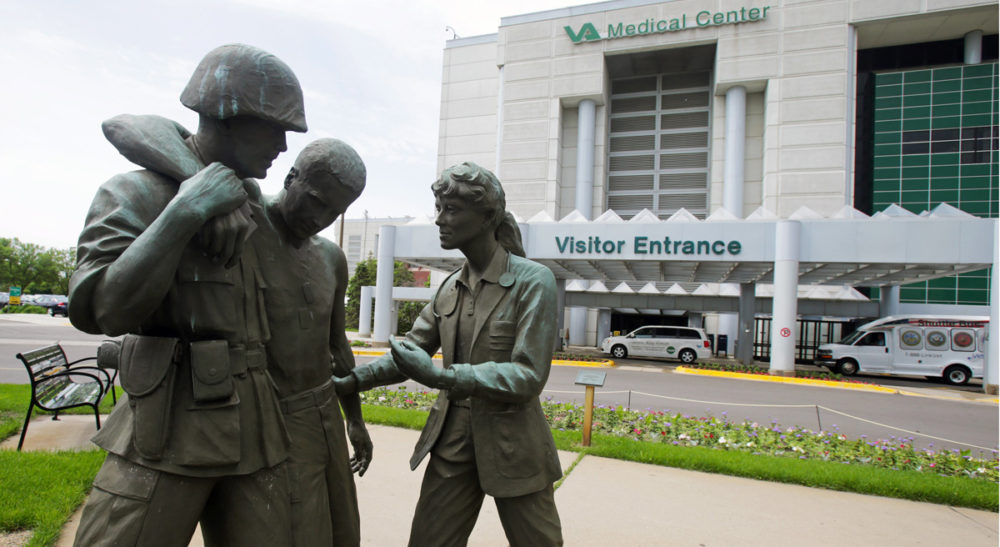Advertisement
Yesterday's VA Is Serving Today's Veterans. Therein Lies The Problem.

The media storm engulfing the Department of Veterans Affairs (VA) misses the main story. The disability claims backlog, the scheduling delays, the bonuses paid to VA officials, fudging the data to meet arbitrary performance targets — these are serious issues. But the root of the VA’s problem is that it was designed for a world that has long since disappeared.
The VA was set up to serve a military that was pre-Internet, pre-antibiotics, pre-all-volunteer armed forces. It was an era when far fewer soldiers survived their battlefield injuries. In the First World War, America lost 100,000 men. Twice that number came home wounded. By contrast, in the Iraq-Afghanistan conflicts, there have been approximately 15 severely wounded survivors for every fatality. Of the 1.8 million soldiers who served in these conflicts and have already been discharged, more than one million have received medical treatment from the VA.
The VA was set up to serve a military that was pre-Internet, pre-antibiotics, pre-all-volunteer armed forces. It was an era when far fewer soldiers survived their battlefield injuries.
Most of these young men and women are entitled to claim disability benefits for the rest of their lives. Multiple deployments and advances in medical diagnostics mean that the average number of disabling conditions per claim is between eight and 10. This compares to just three during Vietnam.
The VA was never designed to handle such volume and complexity. Its claims procedures are enormously bureaucratic. A veteran must gather voluminous documentation to submit a claim to one of the 57 regional VA benefits offices. Each of the disabling conditions listed on the claim has to be validated by a medical specialist in the VA health care system. So an individual veteran claiming the average of eight to 10 conditions must see multiple doctors. One quarter of the claims decisions go to appeal. If the veteran's medical complaints worsen over time, he or she can file an unlimited number of additional claims, each of which goes back through the system. The sheer volume of claims processing, certification and treating those who qualify is overwhelming.
The VA is the world’s second largest government health care system, after the British National Health Service, and it enjoys high satisfaction ratings. Its current problems are partly a result of its own success. Under President Obama's administration, the VA has made it easier for returning veterans and those from previous wars to receive medical care and benefits. Former VA Secretary Eric Shinseki, a wounded war hero, broadened the range of disability benefits, expanded access, simplified the compensation rules for veterans exposed to Agent Orange and Gulf War toxins, administered the new GI education bill and provided five years of free medical care to returning Iraq and Afghanistan service members.
...it makes no sense to require each veteran to go through the VA’s protracted and expensive [claims] process. Instead, discharging service men and women should be required to undergo an "exit" medical examination that is the mirror image of the extensive medical examination he or she receives on enlistment.
The difficulties are also directly related to the military retirement system, itself a relic of an earlier period. Soldiers don’t earn retirement benefits from the Defense department unless they stay in the military for 20 years. But 87 percent of today's service members leave the military long before 20 years are up. For vets returning home after two or three grueling tours, disability compensation has become a kind of substitute for retirement benefits.
The recent VA scandals in Phoenix and elsewhere have focused congressional attention on how to fix the problem. But throwing more money at the VA, which has a budget of $164 billion for 2015 (up from $60 billion in 2001), is not the solution. The CBO estimates that the Sanders-McCain bill (designed to shrink waiting times at VA medical facilities) would add $54 billion per year to the VA budget. The Pentagon spends a further $50 billion on medical care. The government has already hired thousands of additional claims analysts and medical staff, invested billions in IT solutions and staff training and tinkered around every edge — all in support of an outmoded system.
Advertisement
It is time for a fundamental re-think of the Veterans Administration. There are three steps we should take to begin this process.
First, simplify the disability claims process. As of April 2014, according to the VBA Office of Performance and Analysis and Integrity, of the 969,502 Iraq and Afghanistan veterans who have applied for disability benefits to date, only 14,808 (or 1.5 percent) have been denied. With such a low rate of denial, it makes no sense to require each veteran to go through the VA’s protracted and expensive process. Instead, discharging service men and women should be required to undergo an "exit" medical examination that is the mirror image of the extensive medical examination he or she receives on enlistment. Any changes should be automatically approved, and subsequent claims, such as mental health conditions, should be approved upfront. Claims can be audited to detect fraud within two years. This would reduce the burden on the veterans, simplify the system and free up doctors and other scarce resources within the VA to provide treatment rather than claims assessment.
...if veterans can’t obtain timely treatment at a VA facility, the VA should reimburse them for medical treatment outside the system.
Second, if veterans can’t obtain timely treatment at a VA facility, the VA should reimburse them for medical treatment outside the system. Many soldiers are returning to rural communities where there are shortages of doctors, nurses, technicians and other medical personnel. The VA has well-paid vacancies across the country that it is unable to fill. It would be far more efficient to allow veterans to seek treatment in private hospitals, rather than making them wait to see doctors employed by the VA.
Third, President Obama should establish a commission to develop a national strategy for how we deliver the care we have promised to veterans, which is rising into the trillions of dollars. At present, there is no clear strategy for meeting that cost. But the VA cannot solve veterans’ issues alone. Returning troops are still serving in the active military, and the most grievous injuries, such as amputations, brain trauma and burns, are treated at military hospitals. But the transition from military to veteran status is anything but smooth, despite billions invested to harmonize medical information between the Pentagon and the VA. Rising veterans’ needs are also driving up demand for Social Security disability compensation and Medicare. A national commission should consider wide-ranging reforms to how military members receive medical care, disability compensation, and retirement benefits.
In the next five years, hundreds of thousands of U.S. troops will be coming home. One of the lessons from earlier wars is that the needs of veterans grow over time. The cost of paying veterans disability benefits for World War I veterans did not peak until over half a century later, in 1969. The same pattern has occurred after World War II, Korea and Vietnam. With the higher survival rates in Iraq and Afghanistan, we cannot afford to continue muddling through with the status quo, and our veterans deserve better. Instead of pointing fingers and throwing good money after bad, the attention generated by the current furor needs to be directed to re-thinking this challenge.
Related:
